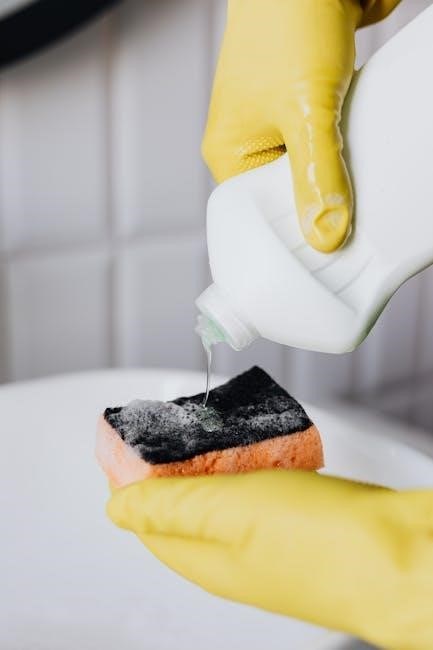
sock washing instructions
Proper sock care maintains hygiene, prevents odor buildup, and extends their lifespan significantly.
The process involves sorting, washing, and drying, ensuring cleanliness and fabric preservation each time.
Importance of Proper Sock Care
Proper sock care is essential for maintaining hygiene, preventing odor buildup, and extending the lifespan of your socks. Socks act as a barrier between your feet and shoes, absorbing sweat and friction. Neglecting their care can lead to bacterial growth, unpleasant smells, and worn-out fabric. Regular washing and drying help keep your feet fresh and healthy. Additionally, proper care prevents colors from fading and fabrics from deteriorating, ensuring your socks remain comfortable and visually appealing. By prioritizing sock care, you invest in both your comfort and the longevity of your footwear accessories. This routine also enhances overall foot health.
Overview of the Washing Process
The washing process involves sorting, cleaning, and drying socks to ensure they remain fresh and durable. Start by separating socks by color and fabric type to prevent damage. Check for stains and pre-treat them before washing. Use a gentle cycle for machine washing or hand wash delicate fabrics. Avoid using harsh detergents or bleach to protect materials. After washing, reshape socks while damp to maintain their fit. Choose between air drying or using a dryer on low heat. Proper washing and drying techniques prevent shrinkage, fading, and odor buildup, keeping your socks comfortable and hygienic. Regular care ensures longevity.
Sorting and Preparing Socks
Sorting socks by color and fabric type prevents damage during washing. Separate delicates from heavier fabrics to ensure gentle care. Check for stains and pre-treat them.
Separating Socks by Color
Separating socks by color is essential to prevent dye bleeding and fabric damage. Whites and light-colored socks should be washed separately from darks. Brightly colored or patterned socks, especially reds and blacks, may bleed dye during washing. Use separate laundry baskets or bags for different colors to maintain vibrancy. Delicate or new socks with intense colors should be washed in cold water or separately to avoid ruining other pairs. This step ensures colors stay vivid and prevents unwanted discoloration. Regularly checking for fading can help determine if additional precautions are needed. Proper sorting enhances sock longevity and appearance.
Separating Socks by Fabric Type
Separating socks by fabric type ensures proper care and prevents damage. Cotton, wool, and synthetic fibers like polyester or nylon have different washing needs. Delicate materials, such as silk or wool, should be washed separately to avoid shrinkage or damage. Thick, heavy-duty socks can withstand tougher cycles, while thin or athletic socks may require gentler care. Sorting by fabric type helps maintain texture, prevents pilling, and extends the life of your socks. This step is crucial for preserving the quality and comfort of your footwear. Proper separation ensures each fabric is treated appropriately during washing.
Checking for Stains and Odors
Before washing, inspect socks for stains and odors to ensure effective cleaning. Common stains like grass, mud, or food can be pre-treated with detergent or stain removers. Odors often linger in the fabric due to sweat and bacteria buildup. Identifying and addressing these issues early prevents them from setting in permanently. Regular checks help maintain hygiene and extend the lifespan of your socks. Pay special attention to the toe and heel areas, where odors and stains are most common. Prompt treatment ensures fresher, cleaner results after washing. This step is essential for optimal sock care and comfort.

Washing Methods
Machine washing is ideal for most socks, using gentle cycles to preserve fabric. Hand washing is recommended for delicate or woolen socks to maintain their quality.
Machine Washing: Settings and Tips
For machine washing, use a gentle cycle with cold water to protect fabrics and colors. Place socks in a mesh laundry bag to prevent snagging. Avoid using harsh detergents or bleach, as they can damage materials. Check the care label for specific instructions, especially for wool or synthetic fibers. Do not overload the washing machine, as this can cause stretching or damage. For heavily soiled socks, pre-treat stains with a mild detergent before washing. Reshape socks after washing to maintain their fit. Air dry or use a low-heat setting to prevent shrinkage and extend sock lifespan. Regular washing keeps socks fresh and hygienic.
Hand Washing for Delicate Socks
For delicate or special-care socks, hand washing is recommended to preserve their quality. Fill a basin with cold water and add a small amount of mild detergent. Gently swish the socks around, avoiding scrubbing or twisting, which can damage fabric. Let them soak for about 15 minutes before rinsing thoroughly. Remove excess water without wringing, then reshape the socks while damp. Lay them flat to air dry, away from direct sunlight or heat. This method ensures delicate materials retain their texture and prevents shrinkage or wear. Avoid using fabric softeners, as they can reduce breathability. Regular hand washing keeps delicate socks fresh and long-lasting.

Drying Socks
Proper drying prevents shrinkage and maintains sock shape. Air drying is ideal, while machine drying should use low heat. Reshape damp socks to retain form.
Air Drying vs. Using a Dryer
Air drying is the recommended method for preserving sock quality, as it prevents shrinkage and maintains elasticity. Place socks flat or hang them to air dry. Using a dryer is faster but risks damaging fabrics, especially delicate or woolen socks. For machine drying, use a low-heat setting and remove socks immediately to prevent wrinkling. Always reshape damp socks to retain their original form. Both methods require careful attention to fabric type and drying conditions to ensure longevity and comfort. Proper drying habits significantly impact sock durability and overall appearance.

Reshaping Socks During Drying
Reshaping socks while damp helps maintain their original form and prevents stretching or misshapen fits. Lay them flat on a clean surface or hang them to air dry. Gently stretch the fabric, especially around the toes and heels, to restore shape. For woolen socks, reshape while damp to prevent shrinkage. Avoid direct sunlight for dark-colored socks to prevent fading. Reshaping ensures comfort and extends the lifespan of your socks. Proper drying techniques, like reshaping, are essential for preserving fabric integrity and maintaining the quality of your socks over time. This simple step makes a significant difference in their appearance and durability.
Special Care Tips
For delicate fabrics, use gentle detergents and cold water to prevent damage. To remove stubborn odors, soak socks in vinegar solution before washing. Reshape woolen socks while damp to maintain their form and elasticity. Avoid fabric softeners, as they can reduce moisture-wicking properties. For hand-washed socks, air-dry them away from direct sunlight to preserve color and texture. Regular washing prevents bacterial buildup, keeping socks fresh and hygienic.
Caring for Woolen Socks
Woolen socks require gentle care to maintain their softness and durability. Hand washing is recommended using cold water and a mild detergent. Avoid machine washing, as it can cause shrinkage or damage. Gently agitate the water, then rinse thoroughly. Reshape the socks while damp to maintain their form. Allow them to air dry away from direct sunlight to prevent fading. Do not tumble dry, as heat can damage the fibers. Store woolen socks in a cool, dry place to prevent moth damage. Regular washing prevents odor buildup, ensuring they remain fresh and comfortable for years. Proper care extends their lifespan significantly.
Removing Stubborn Odors
Stubborn odors in socks can be tackled with targeted cleaning methods. Pre-treat smelly areas with a mixture of baking soda and water before washing. For machine washing, add a detergent designed to combat odors or include a 1/2 cup of white vinegar in the rinse cycle to neutralize smells. For hand washing, soak socks in warm water with a mild detergent and vinegar for 30 minutes. Air drying in sunlight can also help eliminate odors naturally. Repeat washing if the scent persists. Proper drying and storage are key to preventing odor buildup in the future. Regular maintenance ensures freshness and comfort.

Storage and Maintenance
Store clean socks in a cool, dry place to maintain quality. Regularly inspect for damage and mend promptly to extend lifespan and ensure comfort.
Proper Storage to Prevent Damage
Store clean socks in a cool, dry place to prevent moisture buildup and mildew. Use breathable containers or drawers to maintain airflow. Avoid overcrowding, as this can cause stretching or damage. Fold or roll socks neatly to preserve their shape. Keep them away from direct sunlight to prevent fading. For delicate socks, consider storing them in acid-free tissue paper. Check stored socks periodically for signs of pests or wear. Proper storage ensures your socks remain in great condition for a longer period, maintaining both quality and comfort over time.
Maintaining Sock Quality Over Time
To keep socks in excellent condition, adopt consistent care habits. Regular washing prevents dirt buildup, while proper drying avoids shrinkage. Avoid using harsh detergents or bleach, as they can weaken fabrics. For delicate materials, hand washing is recommended. Store socks in a cool, dry place to prevent moisture damage. Repair small holes promptly to prevent them from growing. Rotate your sock collection to ensure even wear. By following these steps, you can extend the life of your socks, maintaining their comfort and appearance over time. Proper maintenance ensures your socks remain durable and comfortable for years.